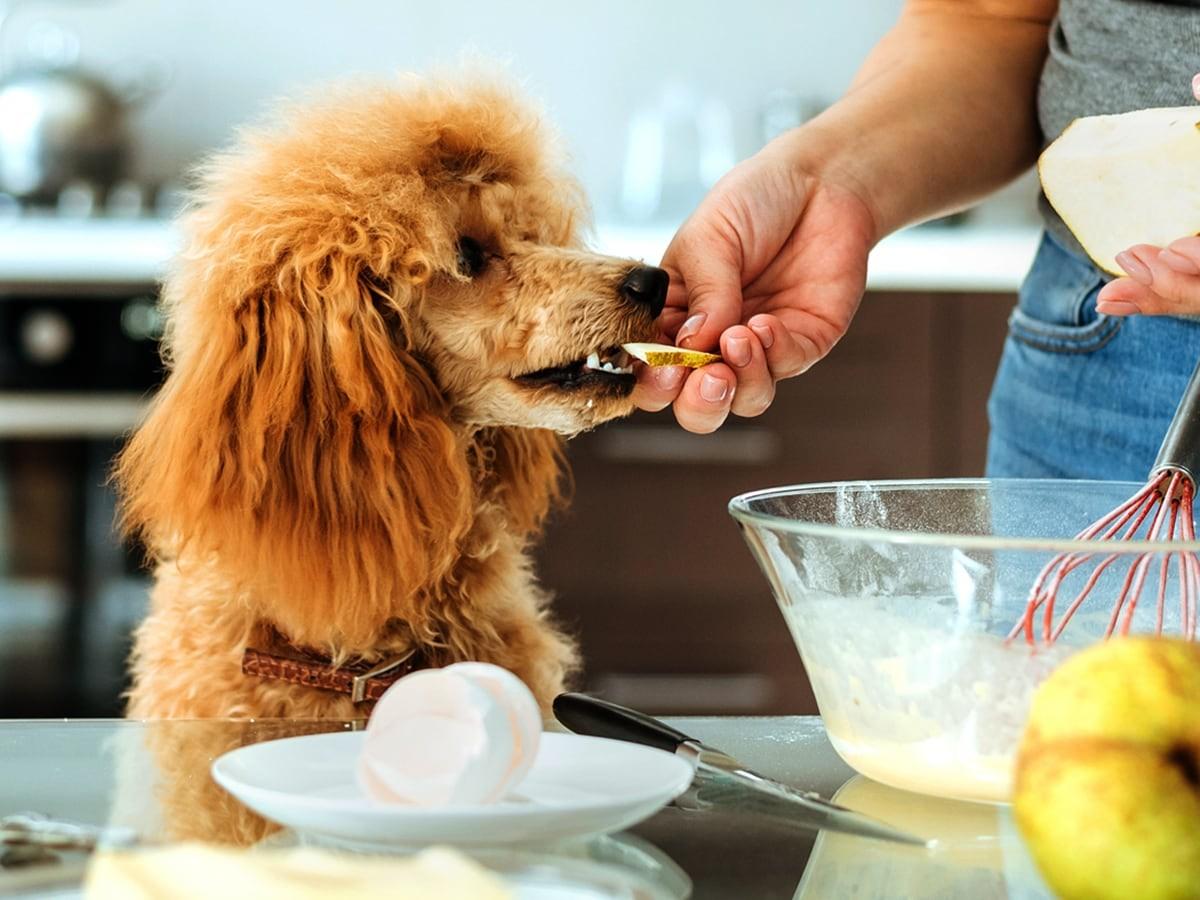Pears are one of the staple fruits that almost everyone eats from time to time. They are incredibly juicy and delicious, an excellent treat for any time of year. If you are a pear fan, you are probably wondering if you can share this treat with your four-legged family member.
Dogs are most definitely one of man’s best friends. Most dog owners think of their dogs as members of their own family, and we can think of no better role for a pup than that of the beloved fur baby.
As a good pet parent, one of your primary concerns is making sure your pup is healthy and well-fed. You also want to make sure that your dog stays out of food they shouldn’t eat, and that means educating yourself about what human foods your dog can and can’t eat.
We’re here to help. At Spot Pet Insurance, we understand that being a pet parent can be difficult. There’s a lot to remember and learn, and taking care of any pet, whether dog or cat, is a lot of work, especially if you recently got a puppy.
We may not be able to help you in a physical sense, but we can certainly help you be prepared. So, can dogs eat pears? The short answer is yes, but there are a few things you need to know before handing your pup a pear.
Are pears good for dogs?
We know now that dogs can eat pears without much danger, but that doesn’t necessarily mean that pears are good for dogs. There are plenty of foods that aren’t poisonous for dogs but don’t provide any health benefits either. Are pears one of those foods?
You’ve probably already guessed it, but no. Pears have a lot of health benefits for both dogs and humans.
However, there are a few concerns to consider when feeding your pup pears. Too many pears can cause health problems. They have a high sugar content, and dogs have trouble digesting large amounts of sugar, even if it is natural sugar.
The nutritional benefits of pears mean that they are still good for dogs, but you should limit the number of pears that you serve your dog.
Dogs are omnivores, so they can eat meat, vegetables, and fruit. The main part of a well-balanced diet for dogs is meat since they need quite a bit of protein. Fruits like pear and vegetables are meant to supplement the good nutrients that already come with meat.
Most dog food brands already have the proper mixture of meat and plants that your dog needs for a well-balanced diet. However, if you’re thinking about using fruit for treats instead of doggy biscuits, pears can make a good substitute.
What are the health benefits of pears?
Most fruits have many vitamins and minerals that help our bodies heal, grow, and fight off potential problems. The same thing applies to our dogs, but we have to be careful since dogs can’t process some foods the way we do.
Pears have plenty of health benefits. They contain things like:
Iron
Fiber
Potassium
Antioxidants
Vitamin A
Vitamin C
Vitamin K
These vitamins, minerals, and other nutritional elements help with many things. Antioxidants protect cells from being damaged by free radicals, which can cause cancer and heart disease, among other things.
The nutrients in pears can also help with digestion. They can keep your dog’s coat healthy and glossy and aid the immune system and organ function. Pears have many benefits for our pups, although some of their good aspects can be harmful in high amounts.
Why should I limit how many pears my dog eats?
Although pears are great for dogs, you need to be aware of some things before you begin adding pears to your dog’s diet.
The flesh of the pear doesn’t have any toxins that you need to worry about, but it does have a lot of fiber and sugar, which won’t harm your pup if they are given to your dog in small amounts.
However, a dog who has too much fiber can have digestive problems, which usually present themselves in the form of diarrhea or vomiting. The right amount of fiber can help prevent constipation, so when your dog has too much fiber, it causes the opposite problem.
The sugar in pears is naturally occurring, so it’s good for us compared to the processed sugar we have in baked goods and other treats, but dogs have problems processing any kind of sugar.
Is there anything in pears that is dangerous for dogs?
Although the majority of the pear is not toxic, there is one part of the pear that you should never give your pup: the core. The core of a pear contains the seeds, which contain cyanide, a toxin.
Although one or two seeds might not hurt your dog, it’s still best to avoid them since they are a choking hazard. Even the flesh can be a choking hazard if the pieces aren’t cut small enough.
How much pear is it okay for dogs to eat?
We’ve mentioned that too many pears can cause health problems since most fruits, like pears, blueberries, or pineapple, have a high level of sugar. So how many pears can you give your dog to eat?
The exact answer depends on the size of your pup, as larger dogs can generally have a few more pear pieces than smaller dogs. The best way to calculate how many pear pieces your dog can have is to use the 10% rule.
Pears are treats, which means they should only take up 10% of your dog’s daily calorie intake. To find the necessary number, look at your dog’s kibble, which should mention how many calories there are per serving.
After you calculate the number of calories your pup has per day, you can use that number to find 10% of your dog’s calorie intake. Generally, you want to take out 10% of the kibble or other dog food you’re using and replace it with treats.
Before you do so, it’s best to discuss any dietary changes with your vet, to ensure that they would benefit your dog. A licensed veterinarian can determine if your dog needs the nutrition from dog food instead of treats.
They can also help figure out how many treats are healthy for your dog to have.
What is the best way to serve pears to a dog?
Our dogs aren’t really built to take a bite of pear and chew and swallow like we do, so preparing the pear for your dog to eat is important. Not only can it keep our pups from choking on the pears, but it’s also a great way to have fun introducing new foods to your pup’s diet.
The easiest way to serve pears is by cutting them up into bite-sized pieces for your dog to enjoy. You could mix these pieces in with a meal one day or use them as incentives in training.
You could also try making smoothies for your dog and mix in other dog-safe ingredients. Pears can also be dipped into plain, all-natural yogurt or peanut butter to add an extra-special, delicious touch.
You can also look for recipes for doggy biscuits that include pear as one of the main ingredients.
Are there any types of pears my dog shouldn’t eat?
We humans are masters of preserving fruits and making baked goods and other delicious treats with fruit. However, most of these other forms of pear, and other fruits, aren’t safe for our pups to enjoy.
Other forms of pear, like canned pears, have a lot of added sugar that isn’t healthy for our dogs to eat, especially since they can’t digest sugar as well as we do. Any form of pear with added sugar or other ingredients is probably best to avoid.
Pears: A sweet but healthy treat
Pears are an excellent treat since they provide nutrients for our dogs that they may not get from a doggy biscuit. If they are prepared in a way that prevents choking or other problems, pears can make a great alternative treat that helps your dog remain healthy and happy.
There are many perks to giving your dog pears, as long as they aren’t allergic. You should remember to limit your pup’s pear intake, though, since too many pear pieces can cause health problems.
With so many different options for serving this delicious treat, you can certainly find a way to get your pup to try it.
Even if you were just worried about your dog eating a bit of pear that fell on the floor, you now know that your pup was safe and that maybe, they might have found a new treat that can keep their tails wagging.
Other Fruits That Are Safe To Eat for Your Dog
If your dog tends to turn up its nose at a treat that’s been offered many times before, or if you simply want to add variety to their diet, you can try these fruits as well:
Remember that grapes and raisins are never fruits you should feed your dog. These have particular enzymes in them that are toxic to dogs—avoid grapes and raisins around your dog like you avoid chocolate! We have compiled a big list of all the fruits your dogs should eat here.
Dogs can eat sweet potatoes and many other vegetables instead.

The resident animal enthusiast at Spot. I have a lifetime of pet parent experience. If it has fur, feathers, or scales, I’ve probably shared my home with it. I aim to be a reliable source, blending experience with a dedication to the well-being of pets.
*Jan 2019 to Aug 2024 Spot Pet Insurance Services, LLC claims data.
"Can Dogs Eat Pears?" Butternut Box, 21 Dec. 2023, https://butternutbox.com/blog/can-dogs-eat-pears.
Barker, Sean. "What Can’t Dogs Eat: 26 Foods That Dogs Can’t Eat." PolyTunnel Gardening, 11 Feb. 2023, https://blog.firsttunnels.co.uk/foods-that-dogs-cant-eat/.
Malmanger, Ellen. "What Fruits Can Dogs Eat?" PetMD, 22 Apr. 2025, https://www.petmd.com/dog/nutrition/what-fruits-can-dogs-eat.
Burke, Anna. “How Many Treats to Give a Dog a Day.” American Kennel Club, 7 Feb. 2023, www.akc.org/expert-advice/nutrition/how-many-treats-can-dog-have/.
The information presented in this article is for educational and informational purposes only and does not constitute or substitute for the advice of your veterinarian.












